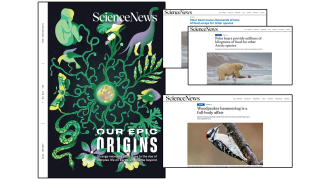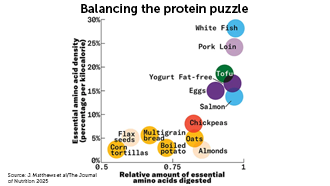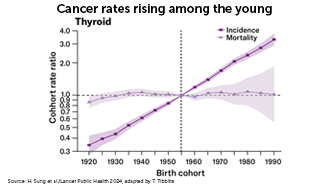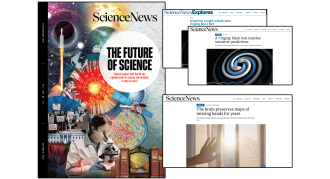Search Results

Polar Bear Predation and Woodpecker Muscles
Incorporate articles from the January issue of Science News to examine a diagram on woodpecker muscle groups and relate them to human anatomy and analyze a polar bear’s place in the Arctic ecosystem.

Balancing the protein puzzle
Protein is having a moment. It’s cropping up as an additive in all sorts of foods, and social media influencers tout high-protein diets as key to big muscles. But people in the United States typically get enough protein; they just might not be getting the right mix.
One species’ trash is another’s treat
Scientists have long noted that polar bears seem to leave much of their prey behind, preferring to eat only the blubber. On first glance, this might look wasteful. But abandoned portions of that carcass might actually benefit other species in the ecosystem. Practice carrying out percentile calculations while answering questions about polar-bear predation strategies, all while discussing the ecological interplay between various species in a harsh Arctic biome.
Woodpecker muscles in action
In this lesson, students will review the human muscular system and then explore how its movements compare with those of woodpeckers. Students will also examine a diagram that shows different woodpecker muscle groups and analyze data from a research article about how those muscles are used while hammering.

Cancer patterns in younger generations
Cancer is typically a disease of older people. But since the 1990s, rates of early onset cancer have been rapidly increasing globally.

Eyes are not all equal
Golden apple snails can completely regrow a functional eye within months of having lost one. Understanding how the snails re-create or repair their eyes might someday lead to therapies to heal people’s eye injuries or reverse some eye diseases.
Ecosystem portrait
In this activity, students will read the Science News Explores article “There’s life beneath the snow — but it’s at risk of melting away” and reflect on how the author of the article educates the reader. After finishing the article, students will create their own ecosystem portrait to educate their classmates about a unique ecosystem.

Ringing Black Holes and Brain Scans
In this educator guide, you’ll find lesson plans matched to articles from the December issue of Science News that ask students to answer questions about gravitational waves and signal-to-noise ratios and to write a scientific question that could be answered using brain scanning technology.
The brain provides answers
Brain scans can help scientists answer questions about how the brain receives information from parts of the body and controls them. In this short activity, students will think of a question that could potentially be answered by brain scans and write a scientific question.
The toll of a black hole
Scientists measured the gravitational waves produced by two colliding black holes. Learn how familiar analogies, such as the toll of a bell, can help comprehend events at the intergalactic scale. Answer questions about the importance of signal-to-noise ratios in science. Then delve deeper by explaining how changing the individual values of a ratio affects the overall ratio.
Claim, Evidence, Reasoning (CER) for any article
Use this claim, evidence, reasoning (CER) template with any Science News or Science News Explores article to have students identify and evaluate a scientific finding from a recent study.

Mapping the Mississippi
Freshwater fish make vast treks, but their migrations remain hidden beneath the surfaces of rivers. This invisibility has left freshwater fish largely overlooked, even as their populations worldwide have plummeted. Now, global “swimways” for migratory fish are emerging as an important conservation focus.